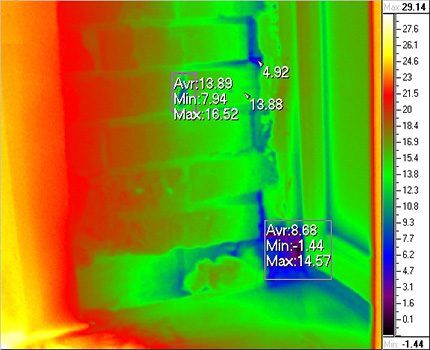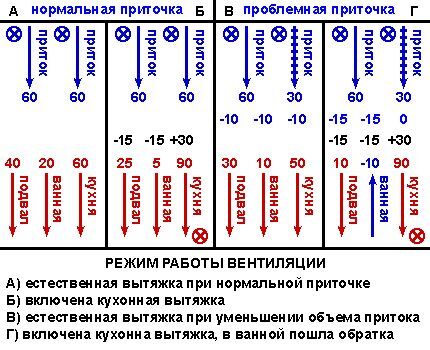Reverse draft in the ventilation of a private house: why ventilation works in the opposite direction and how to eliminate it
To create comfortable conditions, a sufficient supply of fresh air is necessary.If the air exchange system does not function properly, reverse draft may occur in the ventilation of a private house, which has a bad effect on its microclimate.
In this case, it is necessary to understand and eliminate the reasons for the change in flow direction. Let's look at the causes of reverse draft in the ventilation system of a house and how to eliminate them.
The content of the article:
Causes of reverse thrust
Reverse draft occurs when there are miscalculations in the design of the ventilation system or its insufficiently qualified execution. But since air has well-studied physical properties, it is easy to identify the causes of the problem and find ways to eliminate it.
Law of conservation of volume during ventilation
When modeling air exchange for small volumes, which are typical for private houses, it is possible to neglect such air parameters as the degree of compression and uneven density.
In this case, the basic physical law of supply and exhaust ventilation can be formulated as follows: the difference in the volume of incoming and outgoing air for any period of time is zero.
Exhaust ventilation is installed in places with the greatest accumulation of polluting aerosols. These are the bathroom, kitchen and service areas. Some hoods are equipped with fans to forcefully increase the volume of air removed.
Supply ventilation is installed in living rooms to supply fresh air to places where people constantly stay. As a rule, it is of a forced type with predetermined volumes of incoming flow.
This is necessary to accurately maintain microclimate parameters such as temperature, humidity and oxygen conditions.

Thus, most often the volumes of air intake in different places of the house are fixed, and the distribution of outgoing air among the openings is variable.
If at a certain point in time a part of the exhaust system passes a flow greater than that provided by the supply ventilation, the missing volume is compensated through the holes designed to release air.

To prevent such a scenario, it is necessary to perform the following set of actions when developing a ventilation system:
- install a check valve on each exhaust hole to prevent air flow through it;
- organize one or more reserve supply openings of a natural type to compensate for the missing volume.
The cross-section of the holes in the backup air supply devices must be calculated in such a way that they can collectively compensate for the maximum volume of missing air. Each of them must be equipped check valveto prevent air outflow.This is fraught with icing and blockage of inflows in winter.
Unaccounted air exchange with the street
Filtration plays a role in the air balance of a house - the uncontrolled passage of air through cracks and leaks. If this phenomenon is intense, then it is impossible to make accurate calculations of the parameters ventilation system.
In addition, infiltration (inward-directed filtration) allows air to penetrate into the room without treating it with dust filters and without heating it to the desired temperature in winter. Therefore, this phenomenon must be completely eliminated or its impact on the overall air circulation must be made insignificant.

Open windows, balconies and attic doors create additional air exchange. It is impossible to reliably calculate it in advance, since the speed and even the vector of the flow depends on many factors, primarily external and internal temperature, as well as the direction and intensity of the wind.
The only solution when detecting the occurrence of reverse draft in air ducts may be to install check valves.
In cold weather, the chimney serves as an additional variable-power exhaust device. Hot air with combustion products exits through it, making a significant contribution to the total volume of the exhaust flow.
The volume of air exiting through the chimney depends on the power of the boiler. For factory products, it is easy to calculate, since the instructions contain tables that indicate the minimum cross-section of the chimney and the emission rate of combustion products for a specific model.
If the stove or boiler is made independently, then the approximate value of the volume of air removed should be taken from the technical documentation of a device with similar parameters.

If we consider the chimney as an exhaust duct, then its specific feature is the impossibility of installing a check valve on it. An integrated smoke exhauster can be an alternative, but only if its installation is technically possible. Then heating can be included in the model as an extractor hood with a fan.
Calculating the air balance in the presence of a chimney must be approached responsibly. Even a single flow reversal can completely ruin the interior of the room. In addition, with a large flame, there is a risk of fire, as well as the possibility of poisoning people from combustion products.
Typical problems when organizing air exchange
A decrease in the flow rate relative to the calculated one, even in one supply or exhaust, leads to an imbalance in the air circulation in the house. This affects the operation of other devices in which a compensatory change in flow parameters occurs, including the possibility of reverse.
Therefore, it is necessary to examine all places of air inflow and outflow, and then you will be able to find out why general house ventilation works by directing the flow in the opposite direction.

Reducing the volume of incoming air
A decrease in air speed in an air supply unit with a fan can be caused by the following reasons:
- Loss of engine power, fan vibration and other signs of equipment wear. It is necessary to carry out repairs and eliminate any identified faults.
- Failure to configure system settings. It is necessary to reconfigure the system or repair the control unit.
- Filter contamination. The most common reason for a decrease in supply ventilation power. The liner needs to be cleaned or replaced.
- Fan contamination. As a result of the adhesion of pollutants, the geometry of the blades changes. Then, at the same number of revolutions, the pressure characteristic of the device decreases.
- Reducing the live channel cross-section. It can occur in any node of the supply system through which air passes: pipe, heat exchanger, heater, etc. It is necessary to carry out regular service cleaning.
- Partial or complete closing of the outer grille. The filter screen may become clogged with insects, leaves, and other debris. In winter it may be covered with snow. Therefore, you need to periodically check its throughput.
With natural supply ventilation, a common reason leading to insufficient inflow, and sometimes the occurrence of reverse draft, is the effect of rarefied air from the street side.
This phenomenon can occur on the leeward side of the building. This can be eliminated by using special guards near the air intake opening.

Hood malfunctions and their elimination
The reasons for the poor performance of a forced-type hood are the same as for the supply unit. But most often the problem arises not due to contamination of the filters (which are not always installed on the hood), but due to a narrowing of the open cross-section of the ventilation duct.
Unlike fresh air, the exhaust flow carries moisture, vapor, and small drops of fat that stick to the walls of the ventilation duct.
Over time, growths form on the inside, creating aerodynamic resistance, which leads to a decrease in the volume of outgoing air. In this case, the exhaust device itself can work properly.
In private homes ventilation duct is designed so that it can be visually inspected without much effort. This must be done 2-3 times a year and, if any narrowings have formed, clear them yourself or with the help of employees of organizations providing such services.
There are rules for the location of exhaust system pipes on the roof. If they are ignored, then, depending on weather conditions, wind pressure may occur, which leads to a slowdown in the ventilation speed or even the overturning of the draft.
The indicator pointing to this particular cause is variable rather than constant problems with air circulation.
The position of chimneys relative to roof elements is regulated clause 6.6.12 SNiP 41-01-2003 "Heating, ventilation and air conditioning." It is written in this document based on calculations of wind pressure, so it can also be used for ventilation pipes.

A situation often arises when, during the construction of a house, all standards for the placement of ventilation outlets were observed, but later a change in the landscape occurred, leading to the formation of wind pressure zones:
- modification of roof geometry (including installation of a satellite dish);
- construction in the immediate vicinity of a tall building;
- a tree growing nearby.
In this case, you can move the outlet of the ventilation duct to another location, increase the height of the pipe, or try to remove the cause that creates the wind backlash zone.
You also need to check the quality of work deflector. If it has mechanical damage or, as a result of poor fastening, has changed its position relative to the pipe, then this can also cause problems. You can significantly increase traction by replacing an ordinary deflector with a rotary one.
Reverse in the air duct system
In private homes, an air duct system connecting several exhaust vents to one ventilation shaft has become widespread. Some points may be equipped with forced air intake devices, such as a kitchen hood or duct fan.
The occurrence of reverse draft in one of the branches of the air duct can be caused not only by the problems with the general exhaust described above, but also by the redistribution of the flow vector within the ventilation duct system.

To prevent such a scenario, install check valves for each of the air duct branches.These devices allow flow in one direction and close the channel cross-section when it is reversed.
As a rule, when installing an air duct, specialists install check valves. It may not exist in case of additional insertion of branches, if the installation was carried out later. In this case, you need to install such a device. You can do this yourself without rebuilding the entire air duct system.
To do this you need:
- Purchase a valve of suitable sizes.
- Disassemble the air duct system in the place where it will be installed.
- Cut a section of rectangular duct or flexible pipe the size of the valve.
- Assemble the system with the valve.
- Check its tightness.
If a check valve is installed, but backdraft occurs, this means that the device is faulty.
There may be several reasons:
- the appearance of a gap in the membrane, leaf or shell of the valve;
- wear of the moving parts, resulting in the sash or membrane not closing;
- dense debris (for example, a piece of paper or a large beetle) that prevents the device from completely closing.
In any case, it is necessary to disassemble part of the air duct and remove the valve. If it is impossible to repair it, you should purchase a device of the same dimensions and reassemble the air duct.
Conclusions and useful video on the topic
How to make supply ventilation to prevent backdraft in hoods:
Proper operation of exhaust and, especially, supply ventilation is the key to the absence of reverse draft. To do this, it is necessary to periodically inspect the devices and measure the flow rate for them.
If after reading the material you have questions or find inaccuracies, please leave comments in the block below. Perhaps you also have a problem with your ventilation system? Describe it and we will try to deal with it together.




My neighbor had a similar problem, and for quite some time we couldn’t figure out what was wrong? From the hole, which is intended to remove recycled air from the room, it, on the contrary, entered this very room. Until my son came to visit and “Googled” what exactly was the matter. Google brought us here, but here everything is written down to the smallest detail, so detailed and abstruse, as if the author was also teaching physics at the institute. As a result, the problem with reverse draft is solved, and the grateful neighbor is happy as an elephant.
I once had such a problem. The traction went back. I searched for the problem for a long time, but I still didn’t understand what it was. And then everything somehow went away. It will be necessary to call the experts to check the ventilation.
This is the “first bell” about problems in the operation of ventilation, when reverse draft periodically appears. I can give several reasons that lead to this problem:
1. The ventilation ducts are “clogged” with a large amount of steam or cold air, which disrupts normal circulation;
2. It is possible that the channels are clogged with debris or bird nests (in such cases, you can solve the problem yourself);
3. In winter, ventilation ducts can become clogged with ice or snow;
4. In large rooms without partitions, drafts appear and interfere with normal air circulation;
5.Hoods, compressors, fans - all these devices can affect normal circulation and create reverse draft.
As you can see, you don’t always need to call a specialist; in points 2, 3 and 5, the problem can be easily solved on your own.
Hello, in my private house in the kitchen, one hood works on the street, and the second, next to which, from the street, is a house 7 years old, although I didn’t build it.
Hello, we built a house, made 3 hoods (kitchen, bathroom, firebox) and air is blowing into the room everywhere. why is that?
Good afternoon. A private house. Gable roof. Air ducts from the bathroom, kitchen and funroom are combined on the roof in one casing with a hood. When the wind is directed perpendicular to the wall of a house with this common casing on the roof, a draft overturn occurs. How to fix it? Thank you